The Most Significant Influence on the Life and Art of Eugene Boudin Was
| Eugene Boudin - Impressions of the Sea Click on a painting below to start the exhibition
| Boudin's art is the kind of art which wins you over, not past its audacity of expression or the obtrusive violence of its touch, simply by its beauty, which combines intimacy, delicacy and truth innovative in a way considering it developed towards the open air, toward impression…his palette of greys and dejection, his exquisite shading, his consequent harmony were neither conventional nor formulistic – rather, they were an accurate reflection of nature glimpsed sensitively. - Félix Buhot, Journal des Arts, July 14th, 1900, quoted in Vivien Hamilton's Boudin at Trouville, pg. 14 Prior to the formation of the Impressionists, the untrained artist Eugène Boudin had, by the 1860s, already revealed an involvement in plein air painting and the depiction of contemporary land- and seascapes. His option of imagery was influenced by his childhood spent along the coasts of Normandy, rejecting the claustrophobic Parisian scene, and instead faithfully sketching the natural landscape which inspired him most. Indeed, a young Claude-Oscar Monet was start introduced to plein air painting past the older Boudin. It was after watching Boudin, "apprehensively and then more intently," that Monet realized that (quoted in Thousand. Jean-Aubry & Robert Schmit, Eugène Boudin, Greenwich: New York Graphic Gild, 1968, pg. 27): "…information technology was as if a veil had been torn from my eyes. I had understood, I had grasped what painting could be. Boudin'due south absorption of his work, and his independence, were enough to determine the entire future and evolution of my painting." Despite his influence on younger artists, Boudin was a modest and indefatigable worker who was never satisfied with his perceived inability to fully render the splendors that nature set before him. Throughout his career, he struggled to overcome his own melancholic disposition and self-deprecation, despite continual praise from his many acquaintances, of which one could count Constant Troyon, Jean-Francois Millet, Gustave Courbet, Monet, and Charles Baudelaire, to name but a few. Jean-Baptiste-Camille Corot fifty-fifty referred to Boudin as "the rex of skies." Given his personality, Boudin most likely never fully grasped the significance of his creative contribution: that he was the, according to art critic Arsène Alexandre, "precursor" to the Impressionist move, a stepping stone to one of the nigh talked about and, in modernistic times, one of the virtually popular phases in nineteenth century art. Boudin's ability to "conserve an attitude of familiarity with nature…without seeking to flatter or embellish information technology," gave his audiences the opportunity to be "put in direct contact with her," (Claude Roger-Marx, Eugène Boudin: 1824-1898, Paris: Les Editions G. Crès & Cie, 1927, pg. 41) a feature that was often lost on the afterward generations of painters. Eugène Boudin was born in July 12th, 1824 in Honfleur, in the Normandy region of France. He was born into a family whose life revolved around the body of water: both his mother and begetter made their living in the maritime community, his father eventually becoming a helm and his female parent working as a stewardess. Eugène began working alongside his begetter around the age of x, when he became a cabin boy on his father's gunkhole, the Polichinelle, which navigated between Honfleur and Rouen. Aboard the Polichinelle, Eugène began his start drawings, sketching in the margins of his volume. While this experience was undoubtedly important for Eugène's interest in the sea, he did not stay long aboard the Polichinelle subsequently about drowning and given the Polichinelle's unreliable history of capsizing. The family relocated to Le Havre in 1835 where Boudin enrolled in the École des Frères on the rue St. Jacques. He remained here for just 1 year, where he won an award for handwriting and where he was known to draw birds and leaves on his school notebooks. At the stop of the school year, a young Boudin began working for the printer Joseph Morlent before moving shortly thereafter to work with Alphonse Lemasle in his stationery shop on the rue des Drapiers. Lemasle appreciated Boudin'due south diligent nature and took notice of his interest in cartoon. He purchased for him his start fix of paints. Boudin remained with Lemasle until the age of xviii, at which point he left to constitute his own business organization alongside Lemasle's foreman, Jean Acher. Boudin and Acher opened their jotter shop in 1844. A thriving enterprise, it became a middle for local artists, selling not only supplies, but also providing a infinite in which to prove their pieces. It became somewhat of a gallery for local artists and gave Boudin important exposure to a way of life that he had non all the same entirely discovered – that of the artist. It was exactly this penniless being that Jean-Francois Millet cautioned Boudin against engaging in, warning him of the difficulty of such a lifestyle. Boudin did not heed Millet's advice, notwithstanding, since his encounters with other artists such equally Constant Troyon, Thomas Couture, and Eugène Isabey encouraged him to pursue his ain creative explorations. While the business he and Archer had organized had been successful in bringing Boudin into contact with a number of very influential artists, he eventually sold his share of the concern in order to pay some other man to take his place for his obligatory military duty. It was at this moment that Boudin focused his attention solely on beginning his career as an artist. As with any artist embarking on their creative career, he faced extreme difficulty in the showtime years, working tirelessly from dawn to dusk along the seaside, sketching everything that he saw. He experimented with equally many different media equally he could afford – pastels, watercolors, paintings, drawings, and sold bloom paintings and nonetheless-lifes on the side to make ends meet and in lodge to relieve plenty money to travel to Paris. He eventually left for Paris in 1847. What he did not know at this signal was that it would exist his point of origin, the beaches of Normandy, to which he would continually render. Boudin left for Paris with many contacts, but he remained a solitary effigy, spending the majority of his free time studying the old masters of the collection at the Louvre. In 1849 he was recruited to assist the sculptor Louis Rochet on a journey to raise lottery funds that would benefit artists. It was a fortuitous occasion for him, since he was able to go to the museums in Belgium and study painters from the Dutch school, notably Willem Van De Velde, Jacob van Ruysdael, and Paulus Potter. Combined with his previous study at the Louvre and his experiences traveling throughout the regions of northern France and into modern day Benelux, Boudin had been exposed to both the modern and past traditions even though he never had the luxury of artistic preparation that so determined the form that many of his contemporaries eventually followed. After returning to Le Havre, Boudin began exhibiting at the local exhibitions. His public debut came in 1850 at the exhibition of the Société des Amis des Arts in Le Havre. The purchasing committee of the society acquired two of his works and was and so impressed with the artist, that the chairman of the municipal council of Le Havre recommended that Boudin be considered for a travel grant. Under the recommendation of Troyon and others, Boudin was awarded a iii-yr study grant which gave him 1200 francs a year to proceed his work in Paris. Troyon wrote in support of Boudin that "…I tin can say from the lesser of my middle that Boudin is not merely destined to be a dandy painter, just can already be considered on a level with the young painters of our new school." (quoted in Jean-Aubry & Schmit, pg. 15) Boudin arrived in Paris in 1851, but to the dismay of the original commission members who awarded him the grant, he spent the majority of his time exterior of Paris, traveling between Rouen, Le Havre, Honfleur, and Caen, escaping from the confines of the metropolis to commune with the natural landscape. Paris was not suitable for his interest in plein air painting and it offered Boudin little by way of creative freedom, for he wrote that, "In Paris I am like an exile." (Jean-Aubry & Schmit, pg. 127) The idea of composing a painting solely within the studio did non appeal to Boudin. Boudin firmly believed that "Everything that is painted direct and on the spot e'er has strength, a power, and a vivacity of touch which one cannot recover in the studio." (Vivien Hamilton, Boudin at Trouville, ex. cat., London: John Murray Ltd, 1992, pg. 16) For Boudin, "Three strokes of the castor in front end of nature are worth more than two days of work at the easel (in the studio)." (Hamilton, Boudin at Trouville, pg. 16) Only Boudin's method, while en plein air, was yet meticulous in its arrangement. He would execute a vast amount of sketches before composing the final canvas. It was this same reverence towards nature that inevitably caused some of his melancholic despair, mainly in his inability to fully represent the splendors surrounding him. He wrote in his journal in March of 1854 that "Nature is richer than I stand for it." He continued on, regretting that (quoted in Jean-Aubry & Schmit, pg. 24): Nature is and then beautiful that when I'1000 non tortured by poverty I'm tortured by her splendour. How fortunate we are to be able to come across and admire the glories of the sky and earth; if merely I could be content simply to admire them! Just in that location is always the torment of struggling to reproduce them, the impossibility of creating anything within the narrow limits of painting. Nature was the inspiration but also the expletive that impinged upon Boudin'due south power to see the claim of his own production, an aspect that would go along to characterize his career until the end. However, other artists and critics began to take notice of his work every bit his circumvolve of influence and acquaintance continued to expand, despite his reluctance to adhere to any stable group or definition. Charles Baudelaire was the first critic to recognize his talent. In 1859, Boudin debuted at the Parisian salon with Pardon de Saint Anne Palud (Pardon of Saint Anne Palud). Baudelaire had become acquainted with Boudin and his work earlier in the year after visiting his studio. He commented upon Boudin's Salon entry in his Curiosités Esthétiques, placing Boudin'south proper noun among the most progressive artists working at that bespeak. In it, Baudelaire prophesized the bug that the Impressionists would face but would not cull to overcome – the difference between a sketch and a painting, writing that, if other artists visited Boudin's studio as Baudelaire had (Charles Baudelaire, Curiosités Esthétiques , Lausanne: Editions de fifty'Oeil , 1956, pg. 367): ...they would then sympathise what they do not seem to empathize, namely the divergence between a sketch and a picture…He well knows that all this must be made into a flick by applying poetic impression recalled at will: he is not pretentious plenty to claim that his sketches are finished pictures. Even Boudin's finished pieces, however, prove the beginning of a freeness in overall execution adjoining on a sketch-similar rendering. Boudin's search for the ideal setting for his sketches had taken him through Normandy and in 1855, through the region of Brittany and to the cities of Douarnenez, the city of which he had "been dreaming of," (quoted in Jean-Aubry & Schmit, pg. 23) and Quimper. At the communication of his compatriots, Boudin moved to a studio along the rue Pigalle in 1861, simply again, he remained in Paris only equally long as necessary, and instead divided his time for the side by side several years between Paris, Le Havre, and Honfleur. His close friend, Isabey, eventually suggested to Boudin that he travel to Trouville and Deauville to work with beach scenes, two areas that were apace becoming pop sites for bourgeois relaxation. He completed several sketches and paintings in this surface area, focusing on the variation in dress, permutations of the sky, and effects of the environment and weather. Boudin thought these were "if not a grand art, at least a fairly sincere reproduction of the world of our epoch." (Lise Duclaux & Geneviève Monnier, Boudin: Aquarelles et Pastels, ex. cat., Paris: Musée du Louvre, 1965, pg. 68) His work, such equally Plage au Soleil Couchant (Beach with the Setting Dominicus) of 1865, is of unique interest, since (Hamilton, pg. 15): Far from representing the pursuit of a single artistic goal, his art and career, especially during the 1860s, embodied many of the key dilemmas facing painters in those years. In terms of technique, he pursued a autograph method of transcribing his perceptions of the most fleeting natural upshot, and yet he believed that truthful fine art was the product of the artistic imagination; in his field of study matter, he was torn betwixt a fascination with he world of high fashion, on parade on his beloved Normandy beaches, and a feeling for the indigenous community of rural communities; and in seeking markets for his work, he exhibited at the Salon simply also exploited all other possible means of putting his paintings before potential buyers. While these pictures figure equally an of import component in Boudin's total oeuvre, he eventually stopped painting scenes of stylish men and women on the beach in the late 1860s and devoted himself "entirely with studies of the sky, of boats and herds of animals." (Jean-Aubry, pg. 65) Boudin'due south power to capture the subtleties of the sky was an ability that other artists could non match (Tristan Klingsor, "United nations Précurseur de l'Impressionnisme : Eugène Boudin," La Nouvelle Revue, 1891, vol. 8, pg. 262): Where many painters only constitute a pretext for larges surfaces of blue, opaque and muddied, Eugène Boudin astonishes us by a variety and an unequalled accuracy: for him each deject has a physiognomy... to requite us the impression of immensity and to hold our attention, allured by the innovation of a spectacle which everyday we have nether our eyes and which nosotros had never seen. Boudin'due south images found a pocket of popularity with those frequenting the beaches in Normandy. But information technology was non enough to provide him with a comfortable living and Boudin began looking for other means past which to profit from his piece of work. Though not immediately successful, he eventually negotiated enough contacts for his work to be shown semi-regularly at a number of dissimilar dealers. Throughout his career he would try other avenues, too, such as staging his own auctions – Le Havre (1857, 1879), Caen (1862), and Paris (1879, 1888). Overall, these auctions were of limited success and information technology was not until the 1880s when Boudin secured a permanent relationship with Paul Durand-Ruel that Boudin had a consequent sponsor for his piece of work. Fifty-fifty though Boudin was continually submitting to both the Parisian salons and many other provincial Salons, he had yet to receive the public and private presence for which he had hoped. Information technology was not until effectually 1869 that his proper noun began to be recognized on a more regularized basis. He had continued exhibiting at the Parisian Salon since his debut in 1859 and had also begun working with exhibitions in the cities of Rouen, Pau, Roubaix and Grenoble. In 1870 he was sought out by a Belgian dealer, Grand. Gauchez, who commissioned several works from him and invited him to Brussels at the outbreak of the Franco-Prussian war in 1870. Boudin remained here until August, 1871. Despite having several misgivings about the atmosphere and full general environment in Brussels, he returned to Belgium in 1875 and 1876. Despite being shown amongst some of the well-nigh progressive, young artists at this betoken, Boudin was an older man, competing against the energy of youth that slowly began to fail him. His close friends, Millet, Courbet and Corot all passed away within in the mid-1870s, leaving him with a deep feeling of despair exacerbated past his ain malady of facial neuralgia, which would inhibit him for the remainder of his life. However, it was also at this point that Boudin finally began to earn the respect and public renown which had been years in the making. Boudin's successes at the Salon and his interactions with Durand-Ruel fabricated the 1880s the moment of big-calibration arrival – 1881 was the year that "marked the beginning of an 'official' interest in Boudin," as he recounted in his journal. (quoted in Jean-Aubry & Schmit, pg. 95) The critic Edmond Duranty took notice of this and wrote that (quoted in Jean-Aubry & Schmit, pg. 233): This artist'due south impulsive intelligence and initiative has never, since he began to exhibit, won him whatsoever recompense: this is a glaring injustice that ane must never stop to publicize. They will let this painter grow old, they will permit illness weaken him and they will make his decline their pretext for abandoning him to this decease, uncaring of his not bad value. He did, somewhen, achieve such recompense, in the grade of notoriety, public acceptance and sales, and awards. In 1881 Boudin received his starting time medal from the Salon jury, a third class medal for La Meuse a Rotterdam (The Meuse River at Rotterdam) and in 1883 received a 2nd-form medal for L'Entrée (The Entrance) and La Sortie (The Departure). His paintings were too often purchased by the State, such as his 1886 Salon entry Un Grain (A Grain) in 1888, La Corvette Russe Dans le Bassin de L'Eure – Le Havre (Russian Corvette in the Basin of the Eure River – Le Havre), and in 1892, Rade de Villefranche (Villefranche Roadstead), the same year he was named a Chevalier of the Legion of Honor. He continued to submit to the Salon until his death in 1898. Apart from his successful Salon entries, his partnership with Durand-Ruel had proved financially successful. In 1883, Durand-Ruel opened his new gallery on the Boulevard de la Madeleine in Paris with an exhibition of works by Boudin, comprising 150 paintings and other pastels and drawings. Boudin'south sales and successes continued with an 1888 auction at the Hotel Druout in Paris. In 1889, 1890, and 1891, more than successive shows were organized at Galerie Durand-Ruel, and in 1890 he had been elected a member of the Société des Beaux-Arts. His piece of work traveled beyond the Atlantic where it was as well exhibited in Boston (1890, 1891). His works were in demand, but he had not the strength to continue upwardly with the need. His truthful honor and credence had come too late, but he continued his piece of work, as he noted, "I exhaust myself terribly to content the globe, and never manage to content myself." (quoted in Jean-Aubry & Schmit, pg. 115) Boudin became frailer and he was encouraged to spend the winter months in the south of France, near the cities of Villefranche, Antibes, and Beaulieu. He traveled further east to Venice, as well, and eventually returned to the north of France and painted at Dieppe, Fécamp , Le Havre and into surrounding countries. He had one time written in his journal, "I am obsessed with the idea of leaving. I must travel, for that would probably relax me." (quoted Jean-Aubry & Schmit, pg. 21) His wife had passed away in 1889 and it was in traveling and painting that he found his solace. Sensing an impending death, he returned to Deauville, next to the ocean, in 1898, where he died on Baronial 8th of that same year, most like from stomach cancer. In a career that lasted over half a century, Boudin produced over iv,000 paintings and over vii,000 drawings, watercolors, and pastels. (Hamilton, pg. ix) Though his production was fecund, information technology was not until much later in his life that he began to be more fully recognized for the talents that he had been developing for decades. He remained steadfast in his dedication to the body of water and moved from location to location to satisfy his artful desire. His career is important not only for existence an influential artist for a younger generation of Impressionists, but for his ability to cross the borders of a over-politicized and bureaucratic creative system that often stifled many artists' ability to successfully and hands gain a public presence. His participation in such varied exhibitions – from the large scale of the Parisian Salon to more progressive exhibitions such every bit the Impressionist exhibition and those of the Société Nationale des Beaux-Arts – gave him an opportunity to be associated with artists and patrons at varying levels and interests. By the end of his career, Boudin was regarded as the premier marine painter whose popularity continued to abound after his death in 1898. Many of Boudin's painting can be found in the Musée Eugène Boudin in Honfleur as well as the Musée d'Orsay in Paris. The Louvre also possesses the largest drove of Boudin's original watercolors, pastels, and drawings. His work is also featured in numerous other provincial museums throughout France, some of which are located in Pau, Lisieux, Dijon, Evreux, Valenciennes, Rennes, Douai, Rouen, Lyon, Bordeaux, Caen, and Lille. His piece of work is also office of several American collections including the Metropolitan Museum of Art. |
Source: https://www.rehs.com/eugene_louis_boudin_impressions_of_the_sea.html
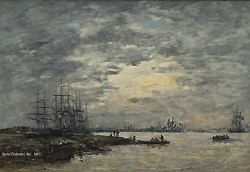
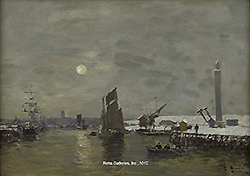
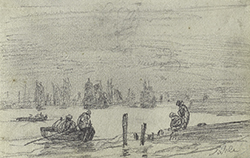
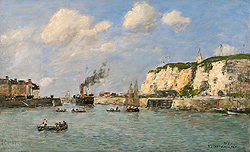
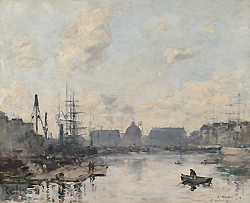
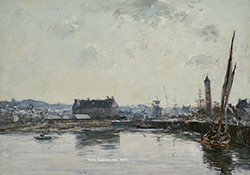
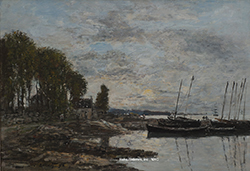
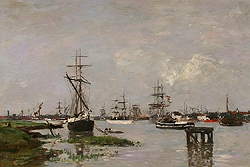
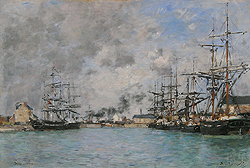
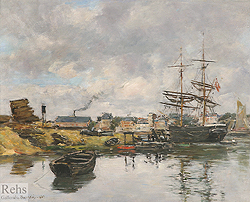
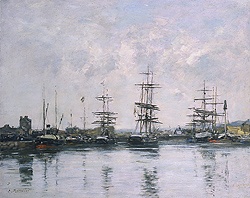
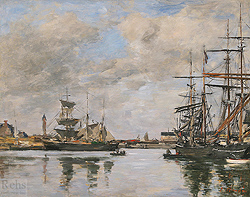
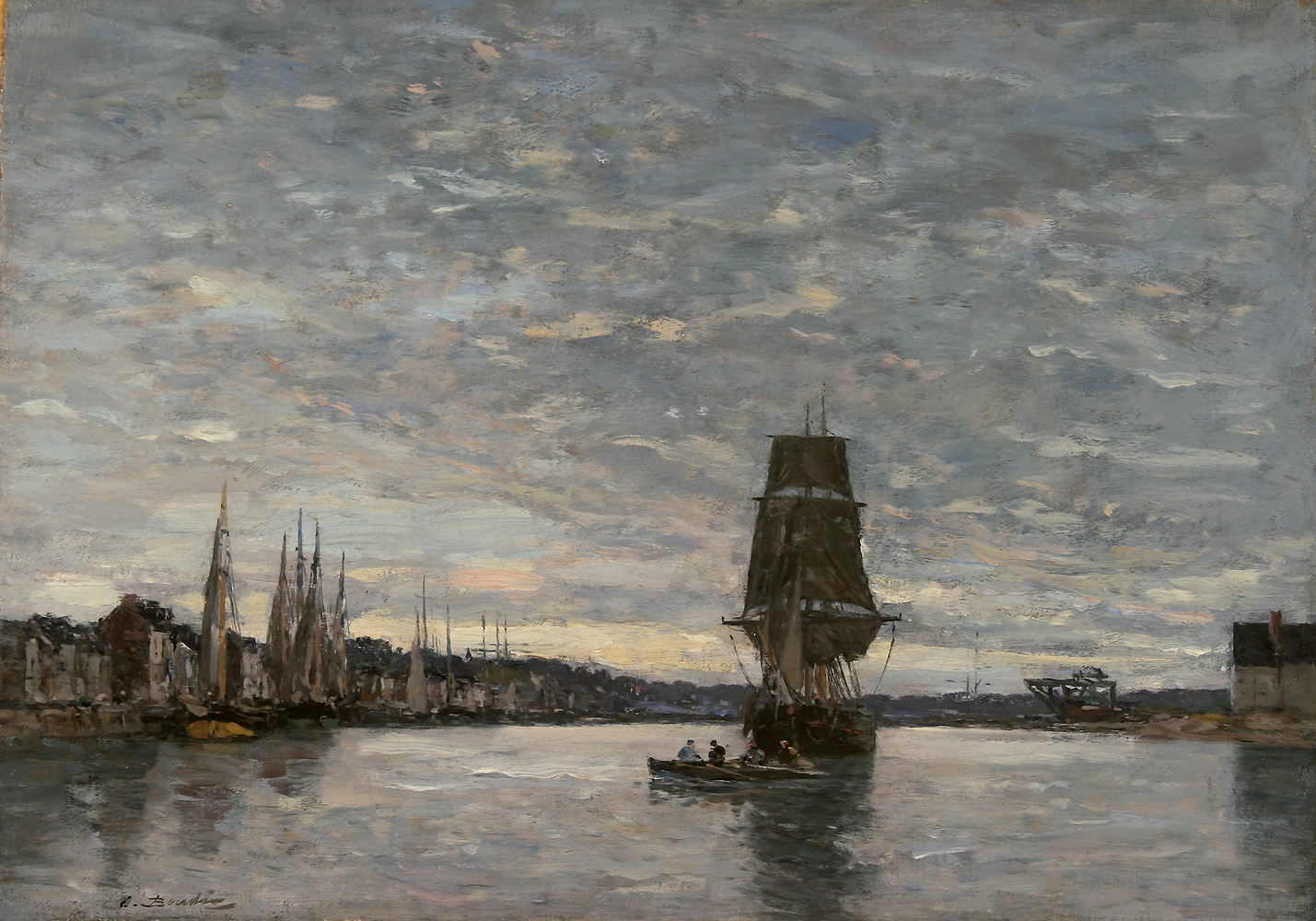
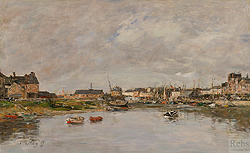
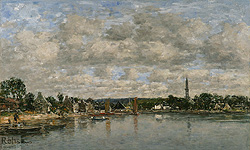
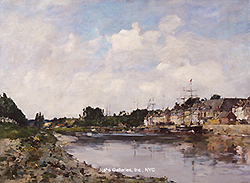
0 Response to "The Most Significant Influence on the Life and Art of Eugene Boudin Was"
Postar um comentário